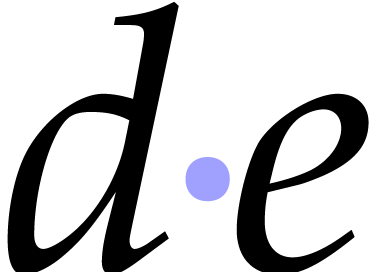Fast computation of generic bivariate
resultants |
|
| May 21, 2020 |
|
 . This paper is
part of a project that has received funding from the French
“Agence de l'Innovation de Défense”.
. This paper is
part of a project that has received funding from the French
“Agence de l'Innovation de Défense”.
We prove that the resultant of two “sufficiently generic” bivariate polynomials over a finite field can be computed in quasi-linear expected time, using a randomized algorithm of Las Vegas type. A similar complexity bound is proved for the computation of the lexicographical Gröbner basis for the ideal generated by the two polynomials.
|
The efficient computation of resultants is a fundamental problem in
elimination theory and for the algebraic resolution of systems of
polynomial equations. Given an effective field  , it is well known [10, chapter 11]
that the resultant of two univariate polynomials
, it is well known [10, chapter 11]
that the resultant of two univariate polynomials  of respective degrees
of respective degrees  can be computed using
can be computed using  field operations in
field operations in  .
Here the soft-Oh notation
.
Here the soft-Oh notation  is an
abbreviation for
is an
abbreviation for  , for any
expression
, for any
expression  .
.
Given two bivariate polynomials  of respective
total degrees
of respective
total degrees  , their
resultant
, their
resultant  in
in  can be
computed in time
can be
computed in time  ;
e.g. see [20, Theorem 25] and references in
that paper. If
;
e.g. see [20, Theorem 25] and references in
that paper. If  , then this
corresponds to a complexity exponent of
, then this
corresponds to a complexity exponent of  in terms
of input/output size. An important open question in algebraic complexity
theory is whether this exponent can be lowered.
in terms
of input/output size. An important open question in algebraic complexity
theory is whether this exponent can be lowered.
In the present paper, we consider the case when  and
and  are “sufficiently generic”. If
the coefficients of
are “sufficiently generic”. If
the coefficients of  and
and  are chosen at random in a finite field
are chosen at random in a finite field  with
sufficiently many elements, then this will be the case with high
probability. Under a suitable hypothesis of “grevlex-lex-generic
position” (defined below) and assuming the random access
memory (RAM) bit complexity model, our main result is the following
theorem:
with
sufficiently many elements, then this will be the case with high
probability. Under a suitable hypothesis of “grevlex-lex-generic
position” (defined below) and assuming the random access
memory (RAM) bit complexity model, our main result is the following
theorem:
 be a fixed rational number. Let
be a fixed rational number. Let
 be two polynomials of respective total degrees
be two polynomials of respective total degrees
 over a finite field
over a finite field  . If
. If  and
and  are in grevlex-lex-generic position, then
are in grevlex-lex-generic position, then  can
be computed in expected time
can
be computed in expected time

using a randomized algorithm of Las Vegas type.
A major result in a similar direction has recently been obtained by
Villard [25]. For a general effective field  , and under different genericity assumptions,
he proposed an algorithm that computes the resultant in
, and under different genericity assumptions,
he proposed an algorithm that computes the resultant in  of two polynomials
of two polynomials  of degree
of degree  in
in  and degree
and degree  in
in  using
using  operations in
operations in  . Here
. Here  is
the usual exponent for matrix multiplication (such that two
is
the usual exponent for matrix multiplication (such that two  matrices over
matrices over  can be multiplied
using
can be multiplied
using  operations in
operations in  ). Le Gall has shown in [19] that one
may take
). Le Gall has shown in [19] that one
may take  .
.
Let  still be a general effective field. Two
common monomial orderings on the polynomial ring
still be a general effective field. Two
common monomial orderings on the polynomial ring  are the lexicographical ordering
are the lexicographical ordering  and the reverse
graded lexicographical ordering
and the reverse
graded lexicographical ordering  defined by
defined by

We say that
 and
and
 are in
lex-generic
(
resp.
grevlex-generic
) position if the leading monomials of the reduced Gröbner basis of
are in
lex-generic
(
resp.
grevlex-generic
) position if the leading monomials of the reduced Gröbner basis of
 with respect to
with respect to
 (
resp.
(
resp.
 )
coincide with the ones that we would obtain when taking symbolic
parameters for the coefficients of
)
coincide with the ones that we would obtain when taking symbolic
parameters for the coefficients of
 and
and
 ;
see Figure
1
;
see Figure
1
 and
and
 are in
grevlex-lex-generic position
when they are both in lex-generic and grevlex-generic position. Notice
that we do not require the ideal
are in
grevlex-lex-generic position
when they are both in lex-generic and grevlex-generic position. Notice
that we do not require the ideal
 to be radical over the algebraic closure of
to be radical over the algebraic closure of
 .
.
The relationship between resultants and Gröbner bases is the
following: if  and
and  are in
lex-generic position, then the reduced Gröbner basis of
are in
lex-generic position, then the reduced Gröbner basis of  with respect to
with respect to  consists of the
minimal polynomial of
consists of the
minimal polynomial of  , which
is a constant multiple of
, which
is a constant multiple of  ,
and the polynomial
,
and the polynomial  for some
for some  with
with  ; see section 4.1.
; see section 4.1.
Assuming that  and
and  are in
grevlex-generic position, the recent result from [12] is an
algorithm to compute a concise representation [12,
Definition 14] of the Gröbner basis of
are in
grevlex-generic position, the recent result from [12] is an
algorithm to compute a concise representation [12,
Definition 14] of the Gröbner basis of  with
respect to
with
respect to  using
using  operations in
operations in  , while
conserving its main properties; see section 3. Note that
the Gröbner basis in its usual representation generically requires
, while
conserving its main properties; see section 3. Note that
the Gröbner basis in its usual representation generically requires
 storage, so its computation is too expensive for
our purposes.
storage, so its computation is too expensive for
our purposes.
If we were able to rapidly convert a Gröbner basis for  into a new one for
into a new one for  ,
then this would allow us to compute resultants in softly linear time.
Unfortunately, traditional “change-of-ordering” algorithms
such as the FGLM algorithm [6, 7] rely on
linear algebra, and do not run in softly linear time. For our proof of
Theorem 1 in section 6, we will instead rely
on a bivariate counterpart of Kedlaya–Umans' algorithm for modular
composition [16]. This technique does not work for general
effective fields
,
then this would allow us to compute resultants in softly linear time.
Unfortunately, traditional “change-of-ordering” algorithms
such as the FGLM algorithm [6, 7] rely on
linear algebra, and do not run in softly linear time. For our proof of
Theorem 1 in section 6, we will instead rely
on a bivariate counterpart of Kedlaya–Umans' algorithm for modular
composition [16]. This technique does not work for general
effective fields  , which
explains the restriction to the case when
, which
explains the restriction to the case when  is a
finite field in Theorem 1.
is a
finite field in Theorem 1.
 , Mehrabi and Schost
[21] showed how to compute a basis of
, Mehrabi and Schost
[21] showed how to compute a basis of  with respect to
with respect to  by means of a probabilistic
algorithm of Monte Carlo type with a nearly optimal bit complexity
bound. Their bound is optimal when the coefficients grow as expected
in the worst case and their method depends on Kedlaya–Umans as
well. This approach has been generalized to higher dimensions in [14]. The probabilistic aspect comes from the need of a
sufficiently generic linear change of the variables. The best known
deterministic complexity bound can be found in [2].
by means of a probabilistic
algorithm of Monte Carlo type with a nearly optimal bit complexity
bound. Their bound is optimal when the coefficients grow as expected
in the worst case and their method depends on Kedlaya–Umans as
well. This approach has been generalized to higher dimensions in [14]. The probabilistic aspect comes from the need of a
sufficiently generic linear change of the variables. The best known
deterministic complexity bound can be found in [2].
Over finite fields, Poteaux and Schost [22, Theorem 1.2]
achieved the computation of bivariate lexicographical bases with bit
complexity  in the special case when
in the special case when  or
or  belongs to
belongs to  , provided that the underlying characteristic
is greater than
, provided that the underlying characteristic
is greater than  , and that
, and that
 is radical, yet without genericity assumption.
Their method extends to an arbitrary number of variables.
is radical, yet without genericity assumption.
Their method extends to an arbitrary number of variables.
Assuming from there on that  and
and  are in grevlex-lex-generic position, we recall in section 4
how to reduce the computation of the resultant to the computation of the
minimal polynomial of the multiplication endomorphism by
are in grevlex-lex-generic position, we recall in section 4
how to reduce the computation of the resultant to the computation of the
minimal polynomial of the multiplication endomorphism by  in
in  . This
minimal polynomial can be computed with high probability using
Wiedemann's algorithm, provided that we have an algorithm for the
transposed map of evaluating a univariate polynomial at
. This
minimal polynomial can be computed with high probability using
Wiedemann's algorithm, provided that we have an algorithm for the
transposed map of evaluating a univariate polynomial at  in
in  . This kind of strategy
has been used several times before in computer algebra [15,
22–24]; see also [10,
chapter 12, section 4].
. This kind of strategy
has been used several times before in computer algebra [15,
22–24]; see also [10,
chapter 12, section 4].
The evaluation of a univariate polynomial at  in
in
 can be regarded as a bivariate modular
composition problem. Exploiting the fact that multiplication in
can be regarded as a bivariate modular
composition problem. Exploiting the fact that multiplication in  is fast (thanks to the concise Gröbner basis
representation), we show in section 5 how to reduce this
problem to multivariate multipoint evaluation. For this reduction, we
mostly follow Kedlaya and Umans, along the same lines as in the proof of
[16, Theorem 3.1] for univariate modular composition;
refinements can be found in [13].
is fast (thanks to the concise Gröbner basis
representation), we show in section 5 how to reduce this
problem to multivariate multipoint evaluation. For this reduction, we
mostly follow Kedlaya and Umans, along the same lines as in the proof of
[16, Theorem 3.1] for univariate modular composition;
refinements can be found in [13].
At that point, we restrict ourselves to the case when  is a finite field, so as to benefit from Kedlaya and Umans' fast
algorithm for multipoint evaluation and its transpose [16].
In section 6, this allows us to conclude the proof of
Theorem 1.
is a finite field, so as to benefit from Kedlaya and Umans' fast
algorithm for multipoint evaluation and its transpose [16].
In section 6, this allows us to conclude the proof of
Theorem 1.
The final section 7 contains a few further notes and directions for future research. In particular, we show that the full lexicographical Gröbner basis can be computed in a similar time as the resultant, with ideas similar to [22] and [8, Algorithm 2]. Finally we quantify the genericity hypotheses in a more precise manner.
 is an effective field.
Most of our algorithms work in the algebraic complexity models of
straight-line programs (SLPs) or computation trees [3],
in which execution times correspond to the required number of field
operations in
is an effective field.
Most of our algorithms work in the algebraic complexity models of
straight-line programs (SLPs) or computation trees [3],
in which execution times correspond to the required number of field
operations in  . The
genericity assumptions imply that non-trivial zero tests always fail,
so the straight-line program framework actually suffices.
. The
genericity assumptions imply that non-trivial zero tests always fail,
so the straight-line program framework actually suffices.
In section 6, where we prove Theorem 1, we
specialize  to become a finite field
to become a finite field  . From that point on, we assume a RAM bit
complexity model and recall that field operations in
. From that point on, we assume a RAM bit
complexity model and recall that field operations in  can be performed in softly linear time
can be performed in softly linear time  .
.
 -vector
space
-vector
space  of
of  that admits
that admits
 as a basis, it is convenient to mentally
represent elements of
as a basis, it is convenient to mentally
represent elements of  as column vectors with
respect to this basis and linear forms
as column vectors with
respect to this basis and linear forms  as row
vectors. Linear maps between two vector spaces
as row
vectors. Linear maps between two vector spaces  of this type correspond to matrices.
of this type correspond to matrices.
Writing  for the set of linear forms
for the set of linear forms  , the transpose of a linear map
, the transpose of a linear map  is the linear map
is the linear map  such that
such that
 for all
for all  .
If
.
If  can be computed by a linear SLP over
can be computed by a linear SLP over  of length
of length  ,
then it is well-known [3, Theorem 13.20] that
,
then it is well-known [3, Theorem 13.20] that  can be computed by an SLP of length
can be computed by an SLP of length  . This “transposition principle” is in
general easy to be put into practice on concrete programs, as
exemplified in [1]. Roughly speaking, the program is
regarded as a composition of individual steps that are easy to
transpose. For the transposition of a composition
. This “transposition principle” is in
general easy to be put into practice on concrete programs, as
exemplified in [1]. Roughly speaking, the program is
regarded as a composition of individual steps that are easy to
transpose. For the transposition of a composition  , where
, where  is another
is another  -linear map, we next apply the
usual formula
-linear map, we next apply the
usual formula  .
.
 and positive integers
and positive integers
 , we define
, we define

Consider a Gröbner basis  of an ideal
of an ideal  for some term ordering on the set of monomials
for some term ordering on the set of monomials  . We write
. We write  for the
for the  -vector space of
polynomials
-vector space of
polynomials  that are reduced with respect to
that are reduced with respect to
 . The reduced monomials in
. The reduced monomials in
 form a basis for
form a basis for  and
correspond to the monomials “under the Gröbner stairs”.
In other words,
and
correspond to the monomials “under the Gröbner stairs”.
In other words,  consists of the monomials that
are not divisible by the leading monomial of an element in
consists of the monomials that
are not divisible by the leading monomial of an element in  . We also write
. We also write

for the map that computes the normal form of a polynomial  with respect to
with respect to  ,
i.e. the unique polynomial
,
i.e. the unique polynomial  in
in  such that
such that  .
.
In the remainder of this paper, let  be two
polynomials of total degrees
be two
polynomials of total degrees  ,
in grevlex-lex-generic position. We write
,
in grevlex-lex-generic position. We write  for
the ideal generated by
for
the ideal generated by  and
and  , and
, and  for the
corresponding quotient algebra. Let us start by recalling several facts
from [12].
for the
corresponding quotient algebra. Let us start by recalling several facts
from [12].
 of
of  with respect to
with respect to  consists of
polynomials
consists of
polynomials  with leading monomials
with leading monomials  ; see [9], [12,
section 2], and Figure 1.
; see [9], [12,
section 2], and Figure 1.
 operations in
operations in  , one may
compute the concise representation of the Gröbner basis
, one may
compute the concise representation of the Gröbner basis  of
of  with respect to
with respect to  . The leading monomials of
. The leading monomials of  and
and  coincide for
coincide for  ,
but
,
but  are not necessarily reduced. Furthermore,
are not necessarily reduced. Furthermore,
 are not explicitly written out (since this
typically requires
are not explicitly written out (since this
typically requires  coefficients in
coefficients in  ); this is why we need to
represent
); this is why we need to
represent  in a concise way, while ensuring
that no essential information is lost.
in a concise way, while ensuring
that no essential information is lost.
 with
with  and
and  , we may compute its normal form
, we may compute its normal form  with respect to
with respect to  using
using  operations in
operations in  .
Recall that
.
Recall that  is the unique element in
is the unique element in  with
with  ; in
particular,
; in
particular,  and
and  coincide.
coincide.
 and
and  are indeed in grevlex-generic position can be checked using
are indeed in grevlex-generic position can be checked using  operations in
operations in  by running the
basis computation and aborting when an irregularity occurs.
by running the
basis computation and aborting when an irregularity occurs.
 has been computed. We
represent elements in the quotient algebra
has been computed. We
represent elements in the quotient algebra  by
normal forms in
by
normal forms in  . Given
. Given
 , we may now compute
, we may now compute  using
using  operations in
operations in  , since
, since  and
and  . By what precedes, we
may therefore compute
. By what precedes, we
may therefore compute  in time
in time  . In other words, products in
. In other words, products in  can be computed in softly linear time.
can be computed in softly linear time.
As above,  and
and  are
polynomials in
are
polynomials in  in grevlex-lex-generic position,
in grevlex-lex-generic position,
 , and
, and  .
.
Consider the  -linear
multiplication map
-linear
multiplication map  . It is
known that the characteristic polynomial
. It is
known that the characteristic polynomial  of this
map equals
of this
map equals  for some
for some  ; see for instance [5, Proposition 2.7]
applied with
; see for instance [5, Proposition 2.7]
applied with  and
and  .
When all the zeros of
.
When all the zeros of  are regular,
are regular,  is separable and the latter property follows more
straightforwardly by comparing the sets of roots of
is separable and the latter property follows more
straightforwardly by comparing the sets of roots of  and of
and of  via the Stickelberger eigenvalue theorem
[18].
via the Stickelberger eigenvalue theorem
[18].
On the other hand, since  and
and  are in lex-generic position, we have
are in lex-generic position, we have

We introduce the minimal polynomial  of
of  as the monic polynomial of minimal degree such that
as the monic polynomial of minimal degree such that  , or, equivalently,
, or, equivalently,  . In particular,
. In particular,  coincides with the unique element of the reduced Gröbner basis of
coincides with the unique element of the reduced Gröbner basis of
 for
for  that belongs to
that belongs to
 .
.
 and
and  in
grevlex-lex-generic position, we have
in
grevlex-lex-generic position, we have  .
In addition, if
.
In addition, if  , then
, then  can be recovered from
can be recovered from  using
using
 operations in
operations in  .
.
Proof. We always have  . The polynomials
. The polynomials  and
and  coincide whenever
coincide whenever  ;
this is the case if and only if
;
this is the case if and only if  and
and  are in lex-generic position.
are in lex-generic position.
Once  is known, since
is known, since  , we may find a
, we may find a  such that
such that
 using
using  operations in
operations in
 , by means of fast multipoint
evaluation. Then the above value
, by means of fast multipoint
evaluation. Then the above value  can be computed
using
can be computed
using  further operations, as
further operations, as

From  and
and  ,
we deduce
,
we deduce  .
.
The above discussion shows that the computation of  reduces to the determination of
reduces to the determination of  .
.
We use Wiedemann's algorithm and the transposition principle for the
computation of  , as follows:
, as follows:
We first select a random linear form  .
More precisely, assuming that
.
More precisely, assuming that  ,
we select a finite subset
,
we select a finite subset  of size
of size  and take
and take  to be a row vector
with random entries from
to be a row vector
with random entries from  .
.
Taking  , we define the
map
, we define the
map

We will explain how to evaluate  efficiently
in section 5.
efficiently
in section 5.
Then we compute the sequence
 |
(1) |
This task is an extension of the usual “power
projection” problem to the bivariate case, since it
corresponds to one evaluation of the transposed map of  :
:

Using the fast variant of the Berlekamp–Massey algorithm [10, chapter 12, Algorithm 12.9 combined with the extended
half-gcd algorithm], we determine the linear recurrence relation of
smallest order  satisfied by the sequence (1). Stated otherwise, this means that we compute the monic
polynomial
satisfied by the sequence (1). Stated otherwise, this means that we compute the monic
polynomial  of minimal degree
of minimal degree  such that
such that

The set of polynomials  for which
for which  for
for  is closed under gcds and
clearly contains
is closed under gcds and
clearly contains  . This
implies that we always have
. This
implies that we always have  .
If
.
If  , then we are sure
that
, then we are sure
that  . The next
subsection reminds why this happens with high probability.
. The next
subsection reminds why this happens with high probability.
The above polynomials  and
and  coincide if, and only if,
coincide if, and only if,  for any irreducible
factor
for any irreducible
factor  of
of  .
Now given an irreducible factor
.
Now given an irreducible factor  of
of  , we have
, we have  .
A random linear form
.
A random linear form  as above annihilates a
fixed non-zero element of
as above annihilates a
fixed non-zero element of  with probability at
most
with probability at
most  . The probability that
. The probability that
 annihilates
annihilates  is therefore
bounded by
is therefore
bounded by  . We conclude that
the probability
. We conclude that
the probability  that none of the
that none of the  irreducible factors
irreducible factors  of
of  annihilates
annihilates  is at least
is at least

The algorithm of the previous subsection and the present probability analysis are summarized in the following lemma.
 and
and  are in
grevlex-lex-generic position and that
are in
grevlex-lex-generic position and that  .
Then the computation of
.
Then the computation of  takes an expected
number of
takes an expected
number of  operations in
operations in  plus an expected number of
plus an expected number of  computations of
sequences
computations of
sequences  .
.
In this section, we show how to efficiently reduce the evaluation of
 to multivariate multipoint evaluation. We mostly
follow the same Kronecker segmentation strategy as in [13,
16, 22] for modular composition.
to multivariate multipoint evaluation. We mostly
follow the same Kronecker segmentation strategy as in [13,
16, 22] for modular composition.
Given an integer  that will be specified later,
let
that will be specified later,
let  be the smallest integer such that
be the smallest integer such that  . We define the Kronecker map
. We define the Kronecker map

as the restriction to  of the unique morphism
of the unique morphism
 of
of  -algebras
that sends
-algebras
that sends  to
to  for
for  . Notice that
. Notice that  is bijective and that both
is bijective and that both  and its inverse can
be computed in linear time with respect to the monomial bases.
and its inverse can
be computed in linear time with respect to the monomial bases.
Let  and
and  be upper bounds
for the degrees in
be upper bounds
for the degrees in  and
and  of elements in
of elements in  . We may
compute
. We may
compute

using binary powering. By what has been said in section 3,
this requires  operations in
operations in  . For any
. For any  and
and  , we notice that
, we notice that

Let  ,
,  , and
, and

Note that  and
and  indeed
hold for
indeed
hold for  . It follows that
. It follows that
We will compute the map  using
evaluation-interpolation. Assume for the time being that
using
evaluation-interpolation. Assume for the time being that  and let
and let  be pairwise distinct
points. Define
be pairwise distinct
points. Define  for
for  .
Setting
.
Setting  ,
,  , consider the evaluation map
, consider the evaluation map

which is a  -linear bijection.
Using traditional univariate evaluation-interpolation in each coordinate
[10, chapter 10], both
-linear bijection.
Using traditional univariate evaluation-interpolation in each coordinate
[10, chapter 10], both  and its
inverse
and its
inverse  can be evaluated using SLPs of length
can be evaluated using SLPs of length
 over
over  .
In particular, we can compute
.
In particular, we can compute
 |
(3) |
in time  . We next define the
map
. We next define the
map

Then we have

Combined with
In section 4, we have reduced the computation of bivariate
resultants to the evaluation of the transposed map  of
of  . In section 5
the evaluation of
. In section 5
the evaluation of  has been reduced to
multivariate multipoint evaluation. We first recall how to perform the
latter evaluation using algorithms by Kedlaya and Umans. We next combine
the above reductions with the transposition principle and prove our main
result.
has been reduced to
multivariate multipoint evaluation. We first recall how to perform the
latter evaluation using algorithms by Kedlaya and Umans. We next combine
the above reductions with the transposition principle and prove our main
result.
Kedlaya and Umans designed various algorithms for modular composition
and multipoint evaluation [16]. They also gave algorithms
for the transposed operations. For the computation of  and its transpose, we will rely on the following result, which is a
direct consequence of [16, Corollary 4.5 and Theorem 7.6]:
and its transpose, we will rely on the following result, which is a
direct consequence of [16, Corollary 4.5 and Theorem 7.6]:
 be a fixed rational number. Given
be a fixed rational number. Given
 and evaluation points
and evaluation points  such that
such that  , there exists an
algorithm that outputs
, there exists an
algorithm that outputs  for
for  , and that runs in time
, and that runs in time

The transpose of the linear map  can be
computed with the same complexity.
can be
computed with the same complexity.
Note that [16, Corollary 4.5 and Theorem 7.6] are actually stated in an more precise manner and that we voluntarily simplified the presentation. We also refer to [13] for some recent refinements.
 and
and

Assume from now on that  .
Before we prove our main result, let us first study the complexity of
evaluating the transpose
.
Before we prove our main result, let us first study the complexity of
evaluating the transpose  of
of  . Recall that the computation of a sequence as
in
. Recall that the computation of a sequence as
in
 be a constant,
thought to be small. Assume that
be a constant,
thought to be small. Assume that  and that the
concise representation of
and that the
concise representation of  and the sets
and the sets  of
of  or of its
transpose
or of its
transpose  takes time
takes time  .
.
Proof. We let

and verify the following bounds:

Theorem 4 therefore implies that  and
and  can be computed in time
can be computed in time  .
.
In the previous sections, we have already shown that  ,
,  and
and  can be computed using
can be computed using  operations over
operations over  . Combining this with (4),
it follows that one evaluation of
. Combining this with (4),
it follows that one evaluation of  takes time
takes time
 .
.
Using our genericity assumptions, we also observed that these
computations can be carried out by linear SLPs over  . In view of the transposition principle (see
section 2), it follows that
. In view of the transposition principle (see
section 2), it follows that  ,
,
 and
and  can also be computed
using
can also be computed
using  operations over
operations over  . Combining this with (4), we conclude
that
. Combining this with (4), we conclude
that

can be computed in time  as well.
as well.
Let us first reduce to the case when  and
and  . Let
. Let  be
the smallest power of
be
the smallest power of  such that
such that  and
and  . Whenever
. Whenever  , we replace
, we replace  by the
extension field
by the
extension field  . Since
. Since  , the construction of
, the construction of  takes bit complexity
takes bit complexity  ,
e.g. by using [10, Corollary 14.39], and the
overhead involved by this extension only concerns hidden logarithmic
factors in the complexity bounds.
,
e.g. by using [10, Corollary 14.39], and the
overhead involved by this extension only concerns hidden logarithmic
factors in the complexity bounds.
Consequently from now  and
and  are satisfied. The concise representation of the Gröbner basis of
are satisfied. The concise representation of the Gröbner basis of
 for
for  takes
takes  operations in
operations in  ,
as recalled in section 3. With
,
as recalled in section 3. With  as
in the proof of Proposition 5, we compute
as
in the proof of Proposition 5, we compute  in time
in time  , and then
, and then  in time
in time  , as
seen in section 5.2. The minimal polynomial
, as
seen in section 5.2. The minimal polynomial  of
of  can therefore be obtained in
expected time
can therefore be obtained in
expected time  , thanks to the
combination of Lemma 3 and Proposition 5. We
finally deduce
, thanks to the
combination of Lemma 3 and Proposition 5. We
finally deduce  from
from  using Lemma 2 and
using Lemma 2 and  further
operations in
further
operations in  .
.
Recall from section 4.1 that  coincides with the unique element in
coincides with the unique element in  of the
Gröbner basis
of the
Gröbner basis  of
of  with respect to
with respect to  and up to a constant multiple
with the resultant
and up to a constant multiple
with the resultant  . It is an
interesting question whether the complete basis
. It is an
interesting question whether the complete basis  can actually be computed fast.
can actually be computed fast.
Now if  and
and  are in
lex-generic position, then
are in
lex-generic position, then  contains exactly one
other element besides
contains exactly one
other element besides  , which
is of the form
, which
is of the form  with
with  . Let us show how to recover this parametrization
. Let us show how to recover this parametrization
 in expected time
in expected time

One technique for doing this goes back to Kronecker [17]:
it performs a first order deformation in order to compute the minimal
polynomial of  modulo
modulo  ; see for instance in [11, section 2].
In the present paper, we appeal to an other known method relying once
more on power projections; as in [8, Algorithm 2], for
instance.
; see for instance in [11, section 2].
In the present paper, we appeal to an other known method relying once
more on power projections; as in [8, Algorithm 2], for
instance.
For this purpose, let  be the linear form that
has successfully led to the computation of
be the linear form that
has successfully led to the computation of  and
let
and
let  be the reciprocal of
be the reciprocal of  . We compute the polynomial
. We compute the polynomial  of degree
of degree  such that
such that  and
and
 are coprime and
are coprime and

Now let  be the linear form that sends
be the linear form that sends  to
to  . This form
. This form
 can be computed in softly linear time by the
transposition principle. Note that the sequence
can be computed in softly linear time by the
transposition principle. Note that the sequence
 |
(5) |
may be obtained in the same way as  , thanks to
Proposition 5. The sequences
, thanks to
Proposition 5. The sequences

where  . It follows that
. It follows that

is a polynomial of degree  .
Since
.
Since  and
and  are coprime,
we finally obtain the reciprocal
are coprime,
we finally obtain the reciprocal  of
of  using
using

This takes  further operations in
further operations in  .
.
We already noted in section 3 that the grevlex-generic
position can be checked using  operations in
operations in
 . Let us now quantify the
genericity of the grevlex-generic position. Write
. Let us now quantify the
genericity of the grevlex-generic position. Write  and
and  . As in [12],
we define
. As in [12],
we define  and
and  ,
which both belong to
,
which both belong to  . By [12, Remark 4] and thanks to the relationship between the
Euclidean remainder sequence and the subresultant polynomials (see for
instance [20, Corollary 3]),
. By [12, Remark 4] and thanks to the relationship between the
Euclidean remainder sequence and the subresultant polynomials (see for
instance [20, Corollary 3]),  and
and
 are in grevlex-generic position if and only if
the following conditions are satisfied:
are in grevlex-generic position if and only if
the following conditions are satisfied:
 and
and  ,
,
The subresultant coefficient  in degree
in degree  of
of  and
and  is non-zero for
is non-zero for  . This
subresultant is the determinant of a square matrix of size
. This
subresultant is the determinant of a square matrix of size  whose entries are coefficients of
whose entries are coefficients of  and
and  ; see for instance
[10, chapter 6].
; see for instance
[10, chapter 6].
The system  admits exactly
admits exactly  solutions counting multiplicities, or equivalently the coefficient
solutions counting multiplicities, or equivalently the coefficient
 of
of  in
in  is non-zero; see for instance [5,
Proposition 2.7] applied with
is non-zero; see for instance [5,
Proposition 2.7] applied with  and
and  . This coefficient
. This coefficient  has total degree
has total degree  in the
coefficients of
in the
coefficients of  and
and  .
.
Overall, there exists a polynomial  in
in  of total degree at most
of total degree at most

such that  implies the grevlex-generic position
of
implies the grevlex-generic position
of  and
and  .
.
In order to show that  is not the zero
polynomial, we construct the auxiliary sequence of polynomials
recursively by
is not the zero
polynomial, we construct the auxiliary sequence of polynomials
recursively by  and starting with with
and starting with with  and
and  , so
, so  ,
,  ,
,
 , etc. We verify by induction
that
, etc. We verify by induction
that  for
for  .
Taking
.
Taking
 |
(6) |
 contains
contains  ,
,
 contains
contains  ,
,
 , and
, and  . In this way
. In this way  is the
Euclidean remainder sequence of
is the
Euclidean remainder sequence of  and
and  . By [20, Corollary 3] all the
subresultant coefficients of
. By [20, Corollary 3] all the
subresultant coefficients of  and
and  are non-zero. In addition, since
are non-zero. In addition, since  and
and  are homogeneous, it is easy to verify that
are homogeneous, it is easy to verify that
 is a non-zero multiple of
is a non-zero multiple of  . Consequently
. Consequently  is not
identically zero.
is not
identically zero.
A sufficient (but non necessary condition) to ensure that  and
and  are in lex-generic position is
that
are in lex-generic position is
that  is separable. The coefficients of
is separable. The coefficients of  have degree
have degree  in the coefficients of
in the coefficients of
 and
and  .
Consequently the discriminant of
.
Consequently the discriminant of  ,
written
,
written  , has total degree
, has total degree
 . When
. When  the lex-generic position holds. To see that
the lex-generic position holds. To see that  is
not identically zero it suffices to take
is
not identically zero it suffices to take  and
and
 : then
: then  is separable for sufficiently generic values of
is separable for sufficiently generic values of  .
.
Our method can be extended in several directions, as we will briefly outline now.
With more work, we expect that the lex-genericity assumption can be
relaxed somewhat, e.g. to the case when the
Gröbner basis for  consists of
polynomials of degree
consists of
polynomials of degree  in
in  . Indeed, using linear algebra techniques
inspired by Wiedemann's algorithm, the idea would be to recover the
characteristic polynomial from the minimal polynomial by determining
the multiplicities of the square-free factors.
. Indeed, using linear algebra techniques
inspired by Wiedemann's algorithm, the idea would be to recover the
characteristic polynomial from the minimal polynomial by determining
the multiplicities of the square-free factors.
Similarly, and as already noticed in [12], it might be
possible to relax the grevlex-genericity assumption somewhat,
e.g. to the case when the Gröbner basis for  consists of
consists of  and
polynomials with leading monomials of the form
and
polynomials with leading monomials of the form  .
.
In [16, section 6], Kedlaya and Umans proposed an algebraic algorithm for multivariate multipoint evaluation (and its transpose, in virtue of the transposition principle). These algorithms are mainly interesting in small characteristic, in which case they can be used instead of the ones from Theorem 4. These algebraic algorithms can also be generalized to more general finite fields, provided that one has an operation for the Frobenius map and its inverse.
Unfortunately, we are not aware of any efficient implementations of
Kedlaya–Umans' algorithms; see [13] for a
discussion about the (very large) input sizes for which the
complexity bounds would become competitive. For the time being, we
therefore do not expect Theorem 1 to induce faster
practical implementations of bivariate resultants. Nevertheless, it
should be noticed that the maps  and
and  can both be regarded as black boxes for our
algorithm: whenever a faster algorithm for one of these maps does
become available, our method might be relevant for practical
applications.
can both be regarded as black boxes for our
algorithm: whenever a faster algorithm for one of these maps does
become available, our method might be relevant for practical
applications.
Using Chinese remaindering and rational reconstruction, the approach
of this paper to compute lexicographical Gröbner bases should
extend to the case when  and
and  have coefficients in
have coefficients in  . In
the generic case, this would provide an interesting, more direct
alternative of Las Vegas type for [21] and [14].
. In
the generic case, this would provide an interesting, more direct
alternative of Las Vegas type for [21] and [14].
A. Bostan, G. Lecerf, and É. Schost. Tellegen's principle into practice. In Hoon Hong, editor, ISSAC '03: Proceedings of the 2003 International Symposium on Symbolic and Algebraic Computation, pages 37–44. New York, NY, USA, 2003. ACM.
Y. Bouzidi, S. Lazard, G. Moroz, M. Pouget, F. Rouillier, and M. Sagraloff. Solving bivariate systems using rational univariate representations. J. Complexity, 2016.
P. Bürgisser, M. Clausen, and M. A. Shokrollahi. Algebraic Complexity Theory, volume 315 of Grundlehren der Mathematischen Wissenschaften. Springer-Verlag, 1997.
D. Cox, J. Little, and D. O'Shea. Ideals, varieties, and algorithms: an introduction to computational algebraic geometry and commutative algebra. Springer Science & Business Media, 2nd edition, 2013.
C. Durvye and G. Lecerf. A concise proof of the Kronecker polynomial system solver from scratch. Expo. Math., 26(2), 2007.
J.-C. Faugère, P. Gaudry, L. Huot, and G. Renault. Sub-cubic change of ordering for Gröbner basis: a probabilistic approach. In K. Nabeshima, editor, ISSAC '14: Proceedings of the 39th International Symposium on Symbolic and Algebraic Computation, pages 170–177. New York, NY, USA, 2014. ACM.
J.-C. Faugère, P. Gianni, D. Lazard, and T. Mora. Efficient computation of zero-dimensional Gröbner bases by change of ordering. J. Symbolic Comput., 16(4):329–344, 1993.
J.-C. Faugère and C. Mou. Sparse FGLM algorithms. J. Symbolic Comput., 80:538–569, 2017.
A. Galligo. A propos du théorème de préparation de Weierstrass. In F. Norguet, editor, Fonctions de plusieurs variables complexes, volume 409 of Lecture Notes in Math., pages 543–579. Springer, Berlin, Heidelberg, 1974.
J. von zur Gathen and J. Gerhard. Modern Computer Algebra. Cambridge University Press, 3rd edition, 2013.
B. Grenet, J. van der Hoeven, and G. Lecerf. Deterministic root finding over finite fields using Graeffe transforms. Appl. Algebra Engrg. Comm. Comput., 27(3):237–257, 2016.
J. van der Hoeven and R. Larrieu. Fast Gröbner basis computation and polynomial reduction for generic bivariate ideals. Appl. Algebra Engrg. Comm. Comput., 30:509–539, 2019.
J. van der Hoeven and G. Lecerf. Fast multivariate multi-point evaluation revisited. J. Complexity, 56:101405, 2020.
J. van der Hoeven and G. Lecerf. On the complexity exponent of polynomial system solving. Found. Comput. Math., 2020. https://doi.org/10.1007/s10208-020-09453-0.
E. Kaltofen and V. Shoup. Subquadratic-time factoring of polynomials over finite fields. Math. Comp., 67(223):1179–1197, 1998.
K. S. Kedlaya and C. Umans. Fast polynomial factorization and modular composition. SIAM J. Comput., 40(6):1767–1802, 2011.
L. Kronecker. Grundzüge einer arithmetischen Theorie der algebraischen Grössen. J. reine angew. Math., 92:1–122, 1882.
D. Lazard. Résolution des systèmes d'équations algébriques. Theoret. Comput. Sci., 15(1):77–110, 1981.
F. Le Gall. Powers of tensors and fast matrix multiplication. In K. Nabeshima, editor, ISSAC '14: Proceedings of the 39th International Symposium on Symbolic and Algebraic Computation, pages 296–303. New York, NY, USA, 2014. ACM.
G. Lecerf. On the complexity of the Lickteig–Roy subresultant algorithm. J. Symbolic Comput., 2019.
E. Mehrabi and É. Schost. A softly optimal Monte Carlo algorithm for solving bivariate polynomial systems over the integers. J. Complexity, 34:78–128, 2016.
A. Poteaux and É. Schost. Modular composition modulo triangular sets and applications. Comput. Complex., 22(3):463–516, 2013.
V. Shoup. Fast construction of irreducible polynomials over finite fields. J. Symbolic Comput., 17(5):371–391, 1994.
V. Shoup. Efficient computation of minimal polynomials in algebraic extensions of finite fields. In Proceedings of the 1999 International Symposium on Symbolic and Algebraic Computation, ISSAC '99, pages 53–58. New York, NY, USA, 1999. ACM.
G. Villard. On computing the resultant of generic bivariate polynomials. In C. Arreche, editor, ISSAC '18: Proceedings of the 2018 ACM International Symposium on Symbolic and Algebraic Computation, pages 391–398. New York, NY, USA, 2018. ACM.